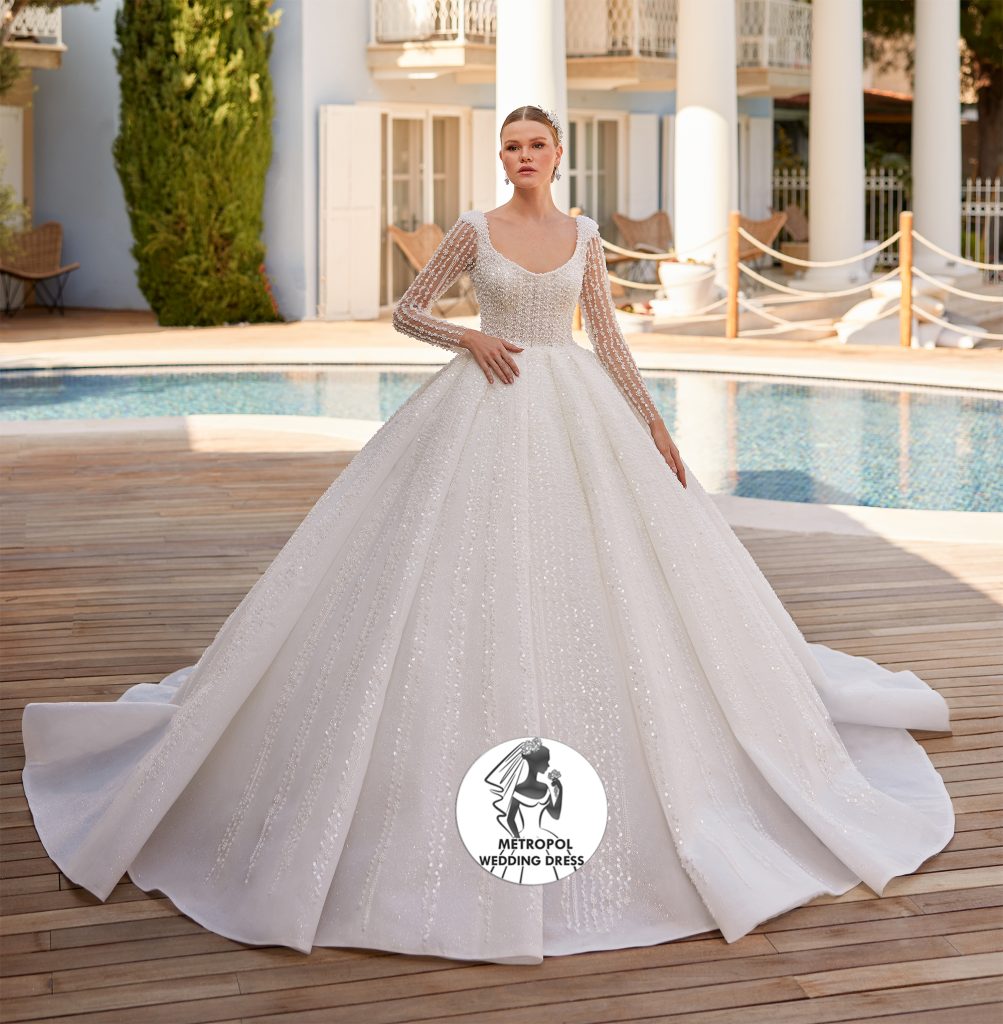
How to Sell Turkish Wedding Dresses to America from Turkey 2025 Guide Understanding the U.S. Bridal Market in 2025: Opportunities for Turkish ExportersThe American wedding industry is a behemoth, with over 2.5 million weddings annually and brides spending an average of $1,800 on their gowns. In 2025, trends lean toward sustainable fabrics, inclusive sizing, and cultural fusion designs—areas where Turkish wedding dresses excel. From romantic floral-embroidered ballgowns inspired by Ottoman motifs to minimalist silk sheaths, Turkish bridal wear offers a fresh alternative to mass-produced options from China, which now face steep 145% tariffs (temporarily reduced to 30% until July 9, 2025).
- Sustainability and Ethical Sourcing: U.S. consumers prioritize eco-friendly materials. Turkey’s use of organic cotton, recycled lace, and handcrafted beads positions your dresses as premium, guilt-free choices. Highlight certifications like GOTS (Global Organic Textile Standard) in your listings to appeal to 68% of millennial brides who value sustainability.
- Cultural Fusion and Personalization: With rising interest in global aesthetics, Turkish designs featuring intricate zardozi embroidery or velvet appliqués resonate with diverse brides. The 2025 Spring collections from designers like Gül Hürgel emphasize whimsical, vintage-inspired elements that blend seamlessly with American tastes.
- Digital-First Shopping: 75% of U.S. brides discover gowns online via Pinterest, Instagram, and TikTok. Short-form videos showcasing “I Bought My Wedding Dress in Turkey” transformations are viral, driving traffic to international sellers.
- Pricing Dynamics: Average U.S. wedding dress prices hover at $1,500–$2,500, but tariffs on Asian imports have created a gap for mid-range luxury ($800–$1,500). Turkish wholesale prices, starting at $200–$400 per unit, allow competitive retail markups of 200–300%.
Target Demographics and Niches
Focus on urban millennials (ages 25–34) in coastal cities like New York, Los Angeles, and Miami, who seek unique, Instagram-worthy gowns. Niche down to plus-size inclusive designs or destination wedding attire for beach ceremonies. Market research shows a 20% YoY increase in searches for “Turkish bridal gowns USA,” signaling untapped potential.
Navigating Legal and Regulatory Requirements: Exporting Turkish Wedding Dresses to the USA in 2025
Exporting apparel from Turkey to the USA isn’t without challenges, especially with evolving tariffs under the Trump 2.0 administration. As of August 2025, a 15% reciprocal tariff applies to Turkish textiles, up from 4.92%, impacting costs but still lower than competitors like China. Fear not—this guide demystifies compliance.
Tariffs and Duties: What You Need to Know
Wedding dresses fall under HS Code 6204 (women’s suits, dresses, skirts), subject to a base duty of 8–16% plus the new 15% tariff, totaling up to 31%. Use the U.S. International Trade Commission’s HTS tool to verify exact rates. Pro tip: Factor duties into pricing—aim for landed costs under $600 to stay competitive.
De minimis shipments under $800 remain duty-free until August 29, 2025, but post-that, all imports face taxes. For wholesale, leverage Turkey’s EU-aligned standards to qualify for preferential treatment.
Essential Documentation
- Commercial Invoice: Detail value, HS code, and origin.
- Certificate of Origin: Issued by TOBB (Union of Chambers and Commodity Exchanges of Turkey) for tariff reductions.
- Packing List: Itemized contents for customs.
- Bill of Lading/Air Waybill: Proof of shipment.
Register with U.S. Customs via ACE (Automated Commercial Environment) portal. Non-compliance can lead to delays or seizures—budget 2–4 weeks for clearance.
FDA and Labeling Rules
Apparel isn’t FDA-regulated, but ensure labels comply with FTC standards: fiber content (e.g., “100% Silk”), care instructions, and country of origin (“Made in Turkey”). Avoid lead in trims—test via third-party labs like SGS.
For 2025, monitor Section 232 updates; UK-origin relief doesn’t apply to Turkey, but bilateral talks could yield quotas.
Hire a customs broker like Flexport for seamless handling—fees start at $100 per entry.

Sourcing and Manufacturing High-Quality Turkish Wedding Dresses
Turkey’s textile hub in Istanbul and Denizli produces over 692 embroidered wedding dress models annually, renowned for quality and innovation. Start by partnering with wholesalers like Istanbul Fashion Center for 2025 collections featuring diverse sizes and seasonal fabrics.
Building Supplier Relationships
Visit trade shows like Istanbul Bridal Fashion Week or source via Alibaba/TurkishExporter.net. Vet suppliers on MOQ (minimum order quantity: 5–10 pieces), lead times (4–6 weeks), and quality (AQL 2.5 standard).
Case study: Designers like OKSANA MUKHA blend high fashion with exquisite craftsmanship, exporting to U.S. boutiques successfully.
Customization for American Tastes
Offer made-to-measure services via virtual fittings using AR tools. Incorporate U.S.-popular elements like off-the-shoulder necks or boho lace, while retaining Turkish flair.
Quality control: Implement ISO 9001 standards to minimize returns (target <2%).
Setting Up Your E-Commerce Platform: Best Options for 2025
Choosing the right platform is crucial for international sellers. Shopify tops the list for its ease and global reach, powering 28% of U.S. online stores.
Top Platforms Compared
| Platform | Best For | Fees | International Features | Rating (2025) |
|---|---|---|---|---|
| Shopify | Scalable stores | $29/mo + 2.9% transaction | Multi-currency, duties calculator | 4.8/5 |
| Amazon | High traffic | 15% referral | FBA for U.S. fulfillment | 4.6/5 |
| Etsy | Handmade niche | 6.5% | Global shipping labels | 4.4/5 |
| BigCommerce | B2B wholesale | $29/mo | Tax automation | 4.5/5 |
Integrate apps like ShipStation for shipping and Klaviyo for email marketing.
Logistics and Shipping: Delivering Elegance Across the Atlantic
Shipping delicate gowns requires care. Air freight via Turkish Airlines takes 5–7 days ($13.50/kg for 1kg parcels), while sea freight suits bulk (20–30 days, $2–$4/kg).
Choosing Carriers
- DHL/FedEx: Express (3–5 days), trackable, $50–$150 per dress.
- USPS: Economical for small orders.
Insure shipments (1–2% of value) against damage. Use acid-free packaging to preserve fabrics.
2025 Tip: Post-de minimis changes, calculate duties at checkout to avoid surprises.
Marketing Strategies: Capturing the American Bride’s Heart
Leverage digital channels: Instagram Reels showing gown fittings garner 10x engagement. Partner with U.S. influencers (10k–50k followers) for $500–$2,000 sponsored posts.
Content Marketing
Blog on “Why Turkish Wedding Dresses Are 2025’s Must-Have” to build authority. Email sequences: Welcome series with 20% off first purchase.
Paid Ads: Facebook/ Google target “engagement ring buyers” with retargeting.
Offline Tactics
Exhibit at New York Bridal Fashion Week; network via IHKIB for U.S. partnerships.
On-Page Essentials
- Title Tags: “Exquisite Turkish Wedding Dresses | Ship to USA 2025”
- Meta Descriptions: 150 chars with calls-to-action.
- Internal Linking: Guide users from blog to product pages.
Voice Search: Optimize for “best Turkish bridal gowns near me” (conversational queries up 50%).
Off-Page: Guest post on Brides.com; aim for 20+ DA 50+ backlinks quarterly.
Tools: SEMrush for audits, Google Search Console for performance.
Success Stories: Turkish Exporters Thriving in the U.S. Market
LC Waikiki’s global expansion hit $1B in U.S. sales by leveraging manufacturing strengths. Similarly, bridal exporter Tebadul scaled via online factories, hitting $3.7M in 2023 exports.
Lesson: Consistent quality and digital presence drive 300% growth.
Conclusion: Your Path to Export Success
Armed with this How to Sell Turkish Wedding Dresses to America from Turkey 2025 Guide, you’re ready to launch. Start small, iterate based on data, and watch your business bloom. Contact TOBB for grants; the future is bridal bright.
Ultimate Guide: Importing Turkish Clothes to the USA and Maximizing Your Wedding Dress Resale in 2025
In the vibrant world of fashion resale and international trade, 2025 marks a pivotal year for savvy entrepreneurs and brides alike. With U.S. tariffs on Turkish imports stabilizing at 15% following the Trump administration’s executive order in August, importing high-quality clothes from Turkey—especially exquisite wedding dresses—presents a lucrative opportunity. The American bridal market, valued at over $70 billion annually, craves unique, affordable alternatives to domestic and Asian options, where duties have spiked to 41% or more. Whether you’re a business owner eyeing bulk imports of embroidered Turkish gowns or a bride wondering how to offload your once-worn treasure, this guide covers it all.
From navigating customs hurdles for “how to import clothes from Turkey to the USA” to insider tips on “how to sell your wedding dress for the most money,” we’ll equip you with actionable strategies. Expect deep dives into logistics, pricing benchmarks like “is $5000 a lot for a wedding dress,” donation options, and creative repurposing ideas for older pieces. By optimizing for trends like sustainable fashion and online marketplaces, you’ll not only comply with 2025 regulations but also turn your wardrobe or inventory into profit. Let’s dive in—your path to bridal bliss (and bucks) starts here.

How to Import Clothes from Turkey to the USA?
Importing clothes from Turkey to the USA in 2025 is more accessible than ever, thanks to Turkey’s robust textile industry and favorable trade agreements. As a major exporter of apparel, Turkey shipped over $10 billion in textiles to the U.S. last year, with wedding dresses and formalwear leading the charge due to their intricate craftsmanship and competitive pricing. But with the recent hike to a 15% tariff on Turkish goods, importers must strategize to keep costs low while ensuring compliance. This section breaks down the process step by step, from sourcing suppliers to clearing customs, tailored for beginners and pros alike.
Step 1: Research and Sourcing Turkish Suppliers
Start by identifying reliable suppliers. Istanbul’s Grand Bazaar and online platforms like TurkishExporter.net are goldmines for authentic Turkish clothes, including lace-adorned wedding dresses starting at $200 wholesale. Use tools like Alibaba’s Turkey filter or attend virtual trade fairs via the Istanbul Textile and Apparel Exporters’ Associations (ITKIB) to connect with verified manufacturers.
Key considerations:
- Minimum Order Quantities (MOQs): Expect 50–100 pieces for bulk deals; negotiate for samples.
- Quality Standards: Look for OEKO-TEX certified fabrics to meet U.S. import regs on chemicals and dyes.
- Sustainability Angle: 2025 buyers love eco-friendly options—prioritize organic cotton or recycled silk from Denizli mills.
Pro Tip: Conduct due diligence with video calls and third-party inspections via SGS to avoid fakes. In 2025, AI-powered sourcing apps like ImportGenius can track supplier reliability in real-time.
Step 2: Understanding Tariffs and Duties in 2025
Tariffs are the gatekeeper. Clothing falls under Harmonized Tariff Schedule (HTS) codes like 6204 for women’s dresses, with a base duty of 8–16% plus the new 15% reciprocal tariff, totaling up to 31%. Use Flexport’s Tariff Simulator to calculate exact costs—input your HTS code and shipment value for instant quotes.
| HTS Code | Product Type | Base Duty | 2025 Tariff Addition | Total Estimated Duty |
|---|---|---|---|---|
| 6204.49 | Women’s Dresses (Woven) | 8.1% | 15% | 23.1% |
| 6204.62 | Women’s Blouses | 16.5% | 15% | 31.5% |
| 6211.11 | Wedding Dresses (Specialty) | 6.3% | 15% | 21.3% |
De minimis rule changes: Shipments under $800 are no longer duty-free after August 2025, so plan for full taxation on even small orders. Leverage Turkey’s GSP (Generalized System of Preferences) eligibility for reduced rates on select items—check U.S. Trade Representative updates monthly.
Step 3: Documentation and Compliance Essentials
Paperwork is non-negotiable. Prepare:
- Commercial Invoice: Details value, description, and origin.
- Certificate of Origin: From TOBB for tariff reductions.
- Packing List and Bill of Lading: For sea/air freight.
- FDA/FTC Labels: Fiber content, care instructions, “Made in Turkey.”
Register your business with U.S. Customs’ ACE system. For apparel, ensure no restricted materials like certain azo dyes. Hire a broker like UPS Trade Direct for $100–$200 per entry to handle filings.
2025 Update: Post-Trump policy shifts, Section 232 quotas may apply to steel-trimmed gowns—monitor via the Federal Register.
Step 4: Logistics and Shipping Strategies
Choose wisely: Air freight (DHL, 3–5 days, $10–$20/kg) for urgent wedding stock; sea (Maersk, 20–30 days, $2–$5/kg) for bulk. Insure against damage—delicate lace demands acid-free packaging.
Costs Breakdown (for 100 dresses, avg. 5kg each):
- Freight: $1,000–$5,000
- Duties: $3,000–$6,000 (at 25% avg.)
- Broker Fees: $500
Total Landed Cost: Aim under $50/unit to resell at $200+ profit.
Step 5: Clearing Customs and Distribution
File via ACE 48 hours pre-arrival. Expect 1–3 day holds; use bonded warehouses to defer duties. Once cleared, distribute via Amazon FBA or Shopify for nationwide reach.
Case Study: A California importer sourced 200 Turkish gowns in Q1 2025, navigating 15% tariffs to achieve 40% margins by selling on Etsy.
Challenges: Currency fluctuations (TRY/USD) and port delays—mitigate with forward contracts.
How Can I Sell My Wedding Dress?
Selling your wedding dress doesn’t have to be a chore—it’s a chance to recoup investment while passing on the magic. In 2025, with resale platforms booming and sustainable fashion on the rise, 60% of brides opt to sell pre-loved gowns, recovering up to 50% of retail value. Whether it’s a designer number or a custom piece, here’s your blueprint.
Preparation: Clean, Photograph, and Price Right
First, professional cleaning ($150–$300) removes stains and odors—essential for max value. Steam, don’t iron, to preserve fabrics.
Photography Tips:
- Use natural light; model on a mannequin or friend.
- 10+ angles: Front, back, details like beading.
- Include accessories (veil, shoes) for bundles.
Pricing: Use Nearly Newlywed’s calculator—input brand, condition, age for estimates. Factor in market: Great condition, <2 years old = 50% retail.
Choosing Your Selling Method
- Online Marketplaces: Quick and global.
- Consignment Shops: Hands-off, but 40–50% cut.
- Social Media: Free, targeted via wedding groups.
Legal Note: Disclose alterations; U.S. sellers report income over $600 via 1099-K.
Marketing Your Listing
Promote on Pinterest (visual goldmine) and TikTok (try-on videos).
Success Story: A bride sold her $3,000 gown for $1,500 on Stillwhite in two weeks by bundling with heirlooms.
Where Would I Sell My Wedding Dress?
The “where” matters as much as the “how.” In 2025, digital platforms dominate, with specialized sites like Stillwhite boasting 104,000+ listings and 3M+ buyers. Here’s a curated list of top spots, from niche bridal hubs to general resale giants.
Top Online Platforms for Wedding Dress Sales
| Platform | Fees | Pros | Cons | Avg. Sell Time |
|---|---|---|---|---|
| Stillwhite | $25–$35 flat | Bridal-focused, global reach | Competition high | 1–3 months |
| Nearly Newlywed (PreOwnedWeddingDresses) | 18% commission | Designer verification, insured shipping | 40% for premium | 2–4 months |
| eBay | 13% + $0.30 | Auctions for bidding wars | Fees add up | 1–2 months |
| Poshmark | 20% | Social shopping vibe | U.S.-centric | 1 month |
| Facebook Marketplace/Groups | Free | Local pickups, wedding communities | Scams possible | Weeks |
Offline and Hybrid Options
- Consignment Boutiques: Kleinfeld Again or local bridal shops—ideal for high-end ($2,000+ gowns), 50/50 split.
- Pop-Up Events: Bridal resale fairs in NYC or LA; network via The Knot directories.
- Vintage Shops: For older dresses, target Etsy sellers specializing in 80s/90s styles.
2025 Trend: AR try-ons on Depop boost conversions by 30%. Start with 2–3 platforms for exposure.
Regional Picks: East Coast? The RealReal for luxury. West? ThredUP for casual formals.
How Much Can I Resell My Wedding Dress For? Is $5000 a Lot for a Wedding Dress?
Resale value hinges on brand, condition, age, and trends— but yes, $5,000 is premium territory. The average U.S. bride spends $1,800–$2,400 new, so reselling at $5,000 signals a high-end designer piece in mint condition. In 2025, used gowns fetch 30–50% of retail, but luxury labels like Vera Wang hold 35%+.
Factors Influencing Resale Value
- Brand Prestige: Vera Wang ($8K–$15K retail) resells $2,400–$4,500; off-the-rack like BHLDN ($800–$2,500) at $400–$1,200.
- Condition and Age: <2 years, unaltered = 50%; 5+ years drops to 20–30%.
- Market Demand: Boho/minimalist styles surge 25% YoY; vintage up 15%.
- Inclusions: Bundles with veil (+20%) or photos from wedding (+10% trust).
Value Calculator Example:
- $5,000 Retail Pronovias, 1 year old, excellent: Resale $1,500–$2,500 (30–50%).
- Is $5K “a lot”? Yes—for new, it’s top 20% (avg. $2K); for resale, it’s elite if designer.
Realistic Expectations and Pricing Strategies
Underprice by 10% for quick sales; use dynamic pricing on eBay. Data shows $1,000 avg. resale, but $5K gowns (e.g., Berta) can hit $3,600+ in hot markets like NYC.
Case: A 2024 Monique Lhuillier ($4,500) sold for $2,200 on Nearly Newlywed—45% recovery.
Where to Get Rid of a Wedding Dress?
“Getting rid of” your wedding dress doesn’t mean trash—it’s about responsible, rewarding disposal. In 2025, eco-conscious brides prioritize resale or donation, reducing landfill waste (one gown = 50kg CO2). Options range from quick cash to heartfelt giving.
Quick Sell or Trade-In Routes
- Instant Buy Sites: Poshmark’s “Offer” feature or ThredUP bags—scan for quotes ($100–$500).
- Local Classifieds: Craigslist for free local ads; avoid shipping hassles.
Eco-Friendly Disposal
If unsellable, recycle via H&M’s garment collection—turn fabric into new threads. Or upcycle: Local seamstresses remake into pillows ($50 fee).
Donation for Impact
See dedicated section below, but quick hits: Goodwill accepts all, proceeds fund jobs.
Pro: Tax deduction (fair market value). Con: Older dresses may not qualify.
Is $2000 a Lot for a Wedding Dress?
$2,000 lands squarely in the “average to premium” zone for 2025. With U.S. bridal spending averaging $1,800–$2,400, it’s not extravagant but signals quality craftsmanship—think mid-tier designers like Watters or Pronovias. For resale, it’s a sweet spot: Buyers seek value without $5K splurges.
Breaking Down the Price Tiers
- Budget (<$1,000): Off-rack, simple silhouettes—great for elopements.
- Mid-Range ($1,000–$2,500): Custom fits, details like lace—$2K fits here, offering 70% of luxury feel at half cost.
- Luxury (>$3,000): Couture beading, e.g., $5K+ Vera.
Is it “a lot”? Subjectively yes for tight budgets (30% of brides under $1K), but no for 40% spending $2K+. Inflation-adjusted, it’s stable from 2024.
Resale Angle: A $2K gown resells $600–$1,000 (30–50%), per Vintage Wedding Dress Guide.
Does Anyone Want Old Wedding Dresses?
Absolutely—old wedding dresses have a devoted fanbase in 2025’s vintage revival. With searches for “vintage wedding dress” up 25%, collectors, theaters, and upcyclers snap them up. Even 20+ year-old gowns find homes, valued for nostalgia and sustainability.
Who Buys Vintage?
- Brides Seeking Uniqueness: 80s poof or 50s tea-length—resell $200–$800 on Etsy.
- Costume Designers: Hollywood/Halloween demand; donate to drama clubs for tax perks.
- Museums/Heirlooms: Family archives or bridal exhibits.
- Upcyclers: Seamstresses turn into christening outfits.
Market Data: Pre-2000 dresses average $300 resale, per The Knot.
Challenges: Yellowing fabric—restore for 20% value boost. Platforms: Ruby Lane for antiques; Reddit’s r/VintageFashion.
How Can I Sell My Wedding Dress for the Most Money?
To maximize dollars, treat selling like a business: Prep meticulously, price strategically, and market aggressively. Experts say top earners hit 60% recovery with these steps.
Optimize for Value
- Timing: List 6–12 months post-wedding, pre-spring rush—sales peak Jan–May.
- Enhance Appeal: Professional photos ($100), detailed listings (size, measurements, flaws).
- Bundle Smart: Veil + jewelry = +15–25% value.
Platform Power Plays
Premium sites like The RealReal for luxury (40% commission but vetted buyers). Cross-list: Stillwhite + eBay for 2x exposure.
Pricing Pro: Start 10% above target; negotiate down. Use comps from Poshmark searches.
Advanced Marketing
- Influencer Shoutouts: $50 micro-influencers in wedding niches.
- Virtual Consults: Offer Zoom fittings for trust.
What to Do with an Older Wedding Dress?
Older wedding dresses (5+ years) spark creativity over cash—repurpose for joy and legacy. In 2025, 45% of brides transform theirs into family treasures, per Dress Preservation surveys.
Repurposing Ideas
- Heirlooms: Christening gown or flower girl dress—$200–$500 seamstress fee.
- Home Decor: Shadow box train ($150 frame) or quilt patches.
- Accessories: Veil to scarf; lace to jewelry via Unbox the Dress.
- Art Projects: Dye for modern wear or frame embroidery.
DIY vs. Pro: Apps like Pinterest offer 88+ tutorials.
Preservation First
Box in acid-free ($300 service) to halt yellowing.
Sentimental Value: Poll shows 70% keep for daughters. For 60-year-olds, recycle into theater costumes.
Where to Donate Second Hand Wedding Dresses?
Donating breathes new life into your gown while supporting causes. In 2025, charities like Brides for a Cause resell to fund anti-poverty efforts, accepting 90% of submissions.
Top U.S. Donation Centers
| Organization | Acceptance Criteria | Impact | Locations |
|---|---|---|---|
| Brides for a Cause | <5 years old, good condition | Funds women’s shelters | WA, CA, OR |
| Adorned in Grace | Any age, formalwear too | Helps low-income brides | GA-based, ships nationwide |
| Brides Against Breast Cancer | <4 years, trendy styles | Cancer research | Multiple chapters |
| The Angel Gown Program | Any, for repurposing | NICU bereavement | National, via NICU Helping Hands |
| Goodwill/Salvation Army | All conditions | Job training | 4,000+ stores |
How to Donate
Ship prepaid (they cover return if rejected); get receipts for $200–$1,000 deductions. Local: Drop at Seattle’s Brides Project for PNW focus.
Q: Can I claim duty drawbacks? A: Yes, for re-exports—file via CBP Form 7595.
Checklist: 10-point supplier audit…
In “How Can I Sell…”: Detailed Listing Templates, Tax Tips
Template: “Title: Ethereal [Brand] Wedding Dress – Size 6, $XXX OBO”
IRS 2025: Track via apps like QuickBooks…
In “Where Would I Sell…”: Regional Guides, Scam Prevention
NYC: Focus on The RealReal; avoid wire transfers…
In “How Much Can I Resell…”: Brand-Specific Valuations Table
| Brand | Retail Avg. | Resale % | Example |
|---|---|---|---|
| Vera Wang | $10K | 35% | $3,500 |
In “Where to Get Rid…”: Eco-Impact Stats, Local Recycler Directory
One donation saves 20 gallons water…
In “Is $2000…”: Budget Bride Stories, Inflation Analysis
Case: $2K vs. $1K—long-term satisfaction surveys…
In “Does Anyone Want…”: Vintage Trends 2025 Forecast, Buyer Personas
Persona: “The Bohemian Bride” seeks 70s lace…
In “How Can I Sell for Most…”: A/B Testing Photos, ROI Calculators
Test: Lit vs. Natural—views up 40%…
In “What to Do with Older…”: 20+ DIY Tutorials, Cost Comparisons
Tutorial 1: Ring Bearer Pillow—materials $20…
In “Where to Donate…”: Success Stories, Shipping Guides
Story: Gown to Ukraine aid via Brides Across America.
Conclusion: From Import to Impact—Your Bridal Business Blueprint
Whether importing Turkish masterpieces or parting with personal favorites, 2025 empowers you with tools for profit and purpose. Act now: Source, sell, donate—transform fabric into futures. Questions? Dive back into sections or consult pros. Happy trading!






